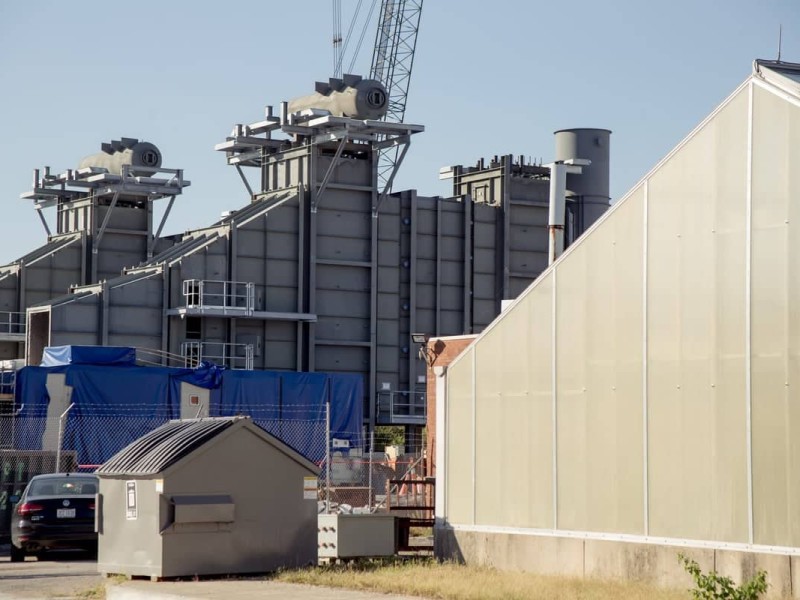Controversial Ohio State power plant incurs delays, rising costs
Originally scheduled to be completed in December 2021 at a cost of $278 million, the still-unfinished power plant is now slated to open this fall at a cost of $420.8 million.

Students and community members gathered outside the planned site of Ohio State University’s new $278 million gas power plant in September 2021 demanding a halt to the construction.
“[OSU] claims one thing [about investing in renewables] and then they do the other,” environmental science student Katy Jobe said at the protest, which took place just months before the plant was due to be completed. Two years later, however, the plant is still unfinished, and the costs have risen to $420.8 million.
Gas Plant on Campus
The combined heat and power (CHP) plant originated as a $278 million plan to “cut carbon emissions by more than 30 percent in its first full year of operations,” according to the Ohio Power Siting Board. The Siting Board also said the plant would generate 105.5 megawatts of electricity using “exhaust energy from natural gas combustion turbine generators to produce high pressure superheated steam through heat recovery steam generators,”
Plans for the gas plant were approved by the Public Utilities Commission of Ohio (PUCO) in September 2020 before its chair, Sam Randazzo, a longtime critic of clean energy, stepped down one year into his first term. In November 2020, the FBI searched Randazzo’s home in connection to an alleged $4.3 million in bribes received from First Energy; he was indicted in December 2023.
The CHP plant was praised by the university as a step toward its 2050 carbon neutral goal. But critics have charged that a power plant relying on fracked gas isn’t clean energy. “The environmental injustices associated with fracking, including the negative environmental effects, negative health outcomes in nearby communities, and the effects of natural disasters, which disproportionately harm marginalized communities, have not been prioritized in the planning and construction of the CHP plant,” read a statement signed by multiple student organizations.
In the same statement, these groups called into question the 30 percent emissions cut, which they said overlooks the fact that more energy will be needed with all of the new buildings and ignores “the fugitive emissions released at the point of [gas] extraction.”
OSU has maintained that the CHP plant was the most realistic option for reducing emissions and providing energy for new projects. But the Sierra Club sought to block the construction of the plant, with the environmental organization arguing that it went against decarbonization plans and citing a 2021 Ohio law that requires the state to approve only projects that represent “the minimum adverse environmental impact.”
Privatizing Public Energy
Before developing plans to build a new gas plant on OSU’s campus, the school sold its energy infrastructure in 2017 for more than $1 billion to two private French companies: the investment firm Axium Infrastructure and the gas and electricity supplier ENGIE. Together they formed the joint venture Ohio State Energy Partners (OSEP) to operate the university’s heating, cooling and power, with plans to build the gas plant.
In a press release, Ohio State said the privatization effort provided “sustainability and high-quality, efficient operations.” As a part of the deal, the university pays OSEP at least $54 million a year for its services. Geoff Chatas, who oversaw the privatization deal in his former role as senior vice president for business and finance at OSU, was also the prime mover behind the privatization of the university’s parking.
Two Years Later and an Extra $140 Million Over
The $278 million plant was originally scheduled to be completed in December 2021. Construction began across from the OSU Veterinary Hospital and greenhouses in late 2020, with the pandemic and other factors combining to delay completion until early 2023. This date was later pushed back, with the price tag increasing to $289.9 million.
In August 2022, construction halted as OSEP issued notices of default and termination to the original contractor of the project, New York-based Frank Lill and Son. After two years of construction, the university brought in a new contractor to take on the already complex project. In October 2022, Florida-based MasTec stepped in to finish the plant, targeting the end of 2023 for completion. But by February 2023, the date and budget were again changed, this time rising to about $300 million and with a targeted completion date of February 2024.
OSU spokesperson Ben Johnson told Matter News that the current plan for the plant is to “open in the fall of 2024” at a cost of $420.8 million. (In a follow-up email, Johnson said university funding for the project has only increased by $26 million, or roughly 20 percent of the total increase.)
Anagha Velamakanni, then OSU co-chair of the Young Democratic Socialists of America, told me in 2021 that the gas plant wasn’t just going to affect her and her classmates, but also generations to come. “After I graduate, guess what’s still going to be there?” Velamakanni said. “The plant.”
She graduated in 2022.



